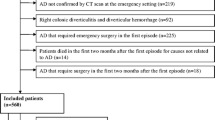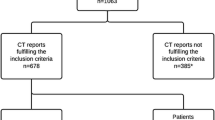Abstract
Introduction
Diverticulosis of the colon is the most occurring abnormality in the digestive tract. Little is known on the risk of developing diverticulitis.
Aim
The study aims to assess the risk of diverticulitis.
Patients and methods
All patients undergoing colonoscopy in the years 1998, 1999, and 2000 were studied. Patients with cancer, inflammatory bowel disease, anastomoses, and prior diverticulitis were excluded. In the summer of 2015, all hospital records, endoscopy reports, and reports from the department of radiology were studied. Diverticulitis had to be confirmed by the clinical presentation but also via ultrasound or CT scan. In order to obtain enough follow-up years, patients above the age of 75 years were excluded.
Results
After exclusions, a study group of 433 patients remained. There was no difference is gender between patients developing diverticulitis and those who did not. There was no difference in age at time of the index colonoscopy. The sum of follow-up years was 6191. Range of follow-up was 0 to 17 years. The mean follow-up was 14.1 years per patient. Thirty cases of diverticulitis (7 %) could be identified; this is 4.8 cases per 1000 years. The mean time to development of diverticulitis was 5.9 years. Diverticulitis had a mild presentation in 19 patients and a severe presentation needing surgical intervention in 11.
Conclusion
The risk of developing diverticulitis is low. This contradicts the belief that diverticulosis has a high rate of progression. These results can help inform patients with diverticulosis about their risk of developing acute diverticulitis.
Similar content being viewed by others
References
Painter NS, Burkitt DP (1971) Diverticular disease of the colon. A deficiency disease of Western civilisation. BMJ 2:450–454
Cheskin LJ, Lampert RD (1995) Diverticular disease. Epidemiology and pharmacological treatment. Drugs Aging 6:55–63
Sheth AA, Longo W, Floch MH (2008) Diverticular disease and diverticulitis. Am J Gastroenterol 103:1550–1556
Mimura T, Bateman AC, Lee RL, Johnson PA, McDonald PJ, Talbot IC, Kamm MA, MacDonald TT, Pender SL (2004) Up-regulation of collagen and tissue inhibitors of matrix metalloproteinase in colonic diverticular disease. Dis Colon Rectum 47:371–378
Horner JL (1952) A study of diverticulitis of the colon in office practice. Gastroenterology 21:223–229
Kubo A, Kagaya T, Nakagawa H (1985) Studies on complications of diverticular disease of the colon. Jpn J Med 24:39–43
Loffeld RJ, Van der Putten AB (2002) Diverticular disease of the colon and concomitant abnormalities in patients undergoing endoscopic evaluation of the large bowel. Color Dis 4:189–192
Loffeld RJ, van der Putten AB (2002) Newly developing diverticular disease of the colon in patients undergoing repeated endoscopic evaluation. J Clin Gastroenterol 35:205–206
Shahedi K, Fuller G, Bolus R, Cohen E, Vu M, Shah R, Agarwal N, Kaneshiro M, Atia M, Sheen V, Kurzbard N, van Oijen MG, Yen L, Hodgkins P, Erder MH, Spiegel B (2013) Long-term risk of acute diverticulitis among patients with incidental diverticulosis found during colonoscopy. Clin Gastroenterol Hepatol 11:1609–1613
Oomen JL, Engel AF, Cuesta MA (2006) Mortality after acute surgery for complications of diverticular disease of the sigmoid colon is almost exclusively due to patient related factors. Color Dis 8:112–119
Henneman D, van Bommel AC, Snijders A, Snijders HS, Tollenaar RA, Wouters MW, Fiocco M (2014) Ranking and rankability of hospital postoperative mortality rates in colorectal cancer surgery. Ann Surg 259:844–849
Author information
Authors and Affiliations
Corresponding author
Additional information
What this paper adds: This study shows that the risk of developing diverticulitis is rather low. This is reassuring for patients diagnosed with this condition.
Rights and permissions
About this article
Cite this article
Loffeld, R.J.L.F. Long-term follow-up and development of diverticulitis in patients diagnosed with diverticulosis of the colon. Int J Colorectal Dis 31, 15–17 (2016). https://doi.org/10.1007/s00384-015-2397-1
Accepted:
Published:
Issue Date:
DOI: https://doi.org/10.1007/s00384-015-2397-1




